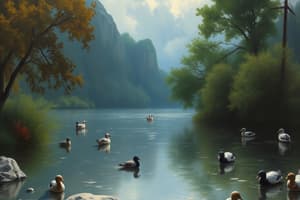Podcast
Questions and Answers
What is the primary purpose of cloning in biotechnology?
What is the primary purpose of cloning in biotechnology?
The primary purpose of cloning in biotechnology is to create genetically identical copies of organisms, cells, or DNA fragments.
Describe gene manipulation and name one method used in this process.
Describe gene manipulation and name one method used in this process.
Gene manipulation refers to the alteration of an organism's genetic material, and one method used is gene splicing.
What role do restriction endonucleases play in the process of gene manipulation?
What role do restriction endonucleases play in the process of gene manipulation?
Restriction endonucleases are enzymes that cut DNA at specific nucleotide sequences, enabling DNA isolation.
How does DNA ligase contribute to DNA cloning?
How does DNA ligase contribute to DNA cloning?
What is a vector in molecular biology, and why is it important?
What is a vector in molecular biology, and why is it important?
Explain the term 'transfection' and in which scenario it is used.
Explain the term 'transfection' and in which scenario it is used.
What is the significance of maintaining the ability to replicate DNA in a vector?
What is the significance of maintaining the ability to replicate DNA in a vector?
What types of vectors are most commonly used in molecular cloning?
What types of vectors are most commonly used in molecular cloning?
What is the structure of plasmids and their primary function in molecular biology?
What is the structure of plasmids and their primary function in molecular biology?
How is a replication origin significant for plasmids used as vectors?
How is a replication origin significant for plasmids used as vectors?
What roles do enhancers and promoters play in gene transcription?
What roles do enhancers and promoters play in gene transcription?
What is a reporter gene, and why is it used in molecular biology?
What is a reporter gene, and why is it used in molecular biology?
Describe the role of antibiotic resistance genes in plasmids.
Describe the role of antibiotic resistance genes in plasmids.
What are viral vectors, and how do they differ from plasmids?
What are viral vectors, and how do they differ from plasmids?
What is the significance of the transcription terminator in gene expression?
What is the significance of the transcription terminator in gene expression?
How does translation initiation occur in bacteria?
How does translation initiation occur in bacteria?
Flashcards
Cloning
Cloning
The process of creating identical copies of an organism, cells, or DNA fragments.
Gene Manipulation
Gene Manipulation
The process of manipulating genetic material using techniques like gene splicing, recombinant DNA, or PCR.
Vector
Vector
A specific sequence of DNA that acts as a carrier of genetic information into cells for replication and expression.
Restriction Endonucleases
Restriction Endonucleases
Signup and view all the flashcards
DNA Ligase
DNA Ligase
Signup and view all the flashcards
Transformation (bacteria) or Transfection (eukaryotes)
Transformation (bacteria) or Transfection (eukaryotes)
Signup and view all the flashcards
Promoter
Promoter
Signup and view all the flashcards
Agarose Gel Electrophoresis
Agarose Gel Electrophoresis
Signup and view all the flashcards
Plasmids
Plasmids
Signup and view all the flashcards
Origin of replication
Origin of replication
Signup and view all the flashcards
Reporter gene
Reporter gene
Signup and view all the flashcards
Enhancer
Enhancer
Signup and view all the flashcards
Transcription terminator
Transcription terminator
Signup and view all the flashcards
Transcription initiation site
Transcription initiation site
Signup and view all the flashcards
Viral vectors
Viral vectors
Signup and view all the flashcards
Study Notes
Cloning in Biotechnology
- Cloning in biotechnology refers to creating clones of organisms, cells, or DNA fragments.
- Gene manipulation, also called genetic engineering, is a general term for methods to manipulate genetic material.
Gene Manipulation Process
- Isolate DNA: Restriction endonucleases (type II) cut DNA at specific locations.
- Insert into vector: DNA is joined to a vector for transport into a host cell.
- Transfer to host: Transfection or transformation inserts the vector into host cells.
DNA Joining
- DNA ligase joins DNA fragments with cohesive ends.
- Agarose gel electrophoresis separates DNA fragments by size.
Vector Importance
- Vectors carry foreign DNA into host cells for replication and expression.
- Vectors must accept foreign DNA and continue the cell cycle.
- Common vectors are bacteria (especially E. coli) or viruses.
- Plasmids are common vectors with circular DNA.
Vector Types
- Cloning vectors introduce foreign DNA into host cells and maintain it within the host organism.
- Plasmids, cosmids, phages, BACs, YACs, or MACs are cloning vectors.
- Expression vectors introduce DNA (gene of interest) and aid in analysing gene products (RNA or proteins).
- Plasmids are expression vectors.
- Both cloning and expression vectors contain: origins of replication, unique restriction sites, a reporter gene and an antibiotic resistance gene.
Insertion Methods
- Transformation: For bacterial cells.
- Transfection: For eukaryotic cells.
- Transduction: For viral vectors.
Viral Vectors
- Viral vectors contain modified DNA or RNA.
- Viral vectors are used to transport foreign DNA to cells.
- Common viral vectors include retroviruses.
Additional Concepts
-
Origin of replication: A specific DNA segment initiating replication.
-
Reporter gene: A gene attached to a regulatory sequence for observation.
-
Plasmids: Small, circular DNA molecules replicated independently.
-
Promoters: DNA regions initiating transcription.
-
Enhancers: DNA sequences increasing transcription likelihood.
-
Transcription terminators: DNA sequences marking the end of a gene.
Studying That Suits You
Use AI to generate personalized quizzes and flashcards to suit your learning preferences.



